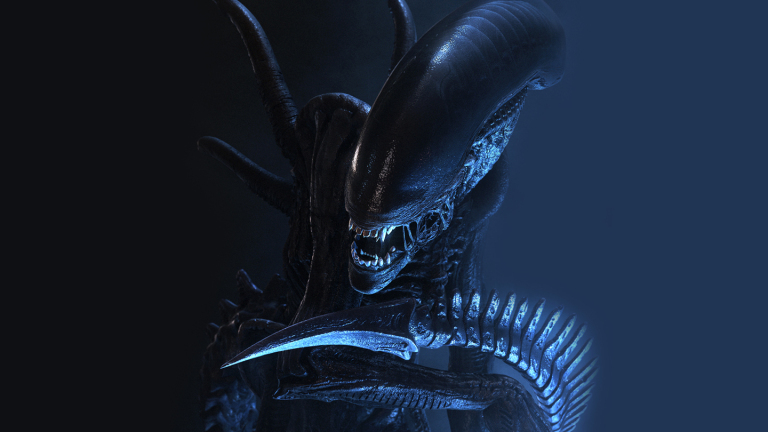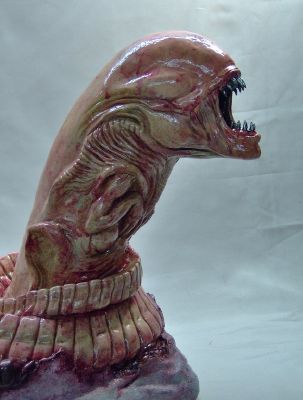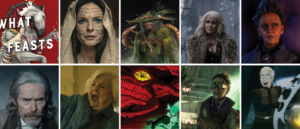My fascination began with the 1979 film Alien. I was six when my parents let me watch it with them one night. The idea of an alien monster, called the Xenomorph in the movie, lurking in the vents of a spaceship was terrifying and invigorating. I wanted to know the Xenomorph’s motives. Why was the crew scared of it? Rewatching the movie as a pre-teen filled in the blanks. The crew feared the unknown, and this alien monster, for me, represented the misunderstood. I associated this monster with how I saw my body: strange, grotesque, and unnatural. It took me until my thirties to confront and reclaim my monsters.

Growing up, my family adhered to strict gender roles. The women wore dresses and skirts and make-up; women should do the cooking and cleaning. The men brought bread to their tables. I avoided dresses for most of my childhood. When I was five and living in Puerto Rico, I played with my friends shirtless. My mother demanded I come back to the house, and she scolded me after I said that I was a boy. I simply didn’t want to wear a shirt like the other boys. It didn’t feel right. After moving to the States a month after turning six, ideas about monsters and shapeshifting dominated my imagination. My family expected me to move and act a certain way — obedient, with closed legs, and a homemaker after marriage. Something inside me told me it wasn’t right. Even if I wasn’t born female, I would have disagreed with the traditional gender beliefs I was raised on.
During middle-school, the idea of turning into a monster not only distracted me from all this, but also empowered me. I wanted to change my body, become whatever I desired. I filled notebook after notebook with stories about monstrous girls that lurked in the shadows of the woods or slithered through the unknown corners of a spaceship. My middle-school self then, outed and bullied for liking a female classmate, survived on that fantasy. Back then, and as I got older, writing stories about Queer shapeshifters soothed me like a lullaby only I could understand, a language only I could translate.
Even after dropping out of undergrad, during the darkest moment of my life, I soothed myself with stories about trans boys and trans men. Post-apocalyptic narratives tackling toxic masculinity. Monstrous trans men falling in love with monstrous women. Stories where trans men have adventures and explore new worlds like their straight counterparts. I once attempted a novella about a monstrous Queer woman in a romantic relationship with a monstrous trans woman. However, when I started attending grad school for an MFA in creative writing, I stopped writing those stories.
Growing up with barely any transmasc representation, I was afraid of what it meant for me to write about trans people. The thought of reading books by and or about trans people scared me. I didn’t want to confront the truth about myself, about this complicated relationship with my body. Once I started writing for my MFA workshops, I couldn’t bring myself to write about trans characters again.

When I thought about my journey to accepting myself, Alien’s chestburster scene came to mind. The violent sexual imagery—the facehugger, and the baby Xenomorph tearing through its host’s chest—haunted me. My self-denial, a monstrous larvae gestating inside me, caught up to me after graduating from grad school. I was in a relationship with a trans woman, I started reading books by trans or genderqueer writers, and I wanted to write about monsters again. But what mostly terrified me was that I began to reimagine my body again. My breasts, gone. A penis replacing my vulva. While I still had my feminine-coded interests like make-up and girl-targeted cartoons, I hesitated at confronting my gender identity.
In the summer of 2020, I came out as nonbinary transmasculine. I wanted to write about my trans monsters again. I wanted to return to the things that scared and intrigued me. Rewatching Alien for the first time in several years offered me a new perspective: to be Queer was to be feared because I refused to stay hidden from people who misunderstood. My desire to write about my monsters had returned then, this time fiercer than before. People who shapeshift into your worst nightmares, kind monsters, characters who eventually embrace their monstrosity. I finally found my monsters. I finally found myself.
All images in this article via Alien (1979).



One Response